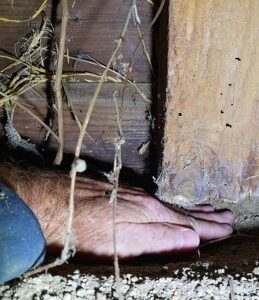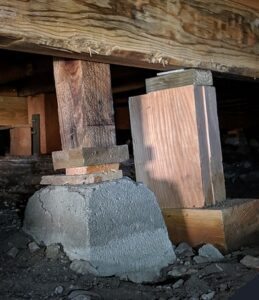Crawl spaces are fantastic – they’re a great place to stash run-money or your mother’s dusty mason jars or just an excellent place to have a good crawl-and-cry (they’re very therapeutic).
The point is: crawl space foundations are a dime-a-dozen across the star-spangled-states.
Unfortunately, crawl space foundations are not only susceptible to the usual expansive soil suspects (foundation settlement and foundation heave) but also have their own unique, intrinsic complications.
Note – If you’re a history buff and want to learn about the 5 main types of foundations found in Uncle Sam’s backyard, check out Foundations Popular in America: A brief Foundational Overview.
Some warning signs that you might be dealing with crawl space issues are:
- You have sloping floors (vertigo for days)
- You have cracks in your drywall
- You struggle to open sticky doors/windows (are contemplating steroids)
- Your asthma and/or allergy symptoms are deteriorating (allergens and asthma triggers can float up through the floorboards / might also have you contemplating steroids)
If you have any of the symptoms above, you might very well be dealing with some of the issues we are going to jump into. In this article, we are going to cover:
- Sloping floors (Crawl Space Jacks)
- Post & Pad Replacement
- Earthquakes (Seismic Retrofitting)
- Stem wall Repair
The good news is, if you live in Southern California or Arizona, Dalinghaus Construction Inc. can handle all of the problems above no prob.
However, in the interest of a holistic approach, we might mention a few complications we don’t fix directly mostly because we don’t see them in our backyard.
So, with that in mind, let’s get started.
Check out our post: Why Is There Water In My Crawlspace?
Sloping Floors
Sloping/bowed/uneven floors have long been a sign and symptom of foundation issues.
The goal is to always be able to walk around your house without experiencing vertigo or be worried about tripping (although, the dips are kind of cool if you have Heelys).
This happens because your home is essentially hollow right beneath your feet, allowing ample space and opportunity for bowing.

We utilize crawl space jacks (comprised of badass galvanized steel) that connect directly to the concrete base and secure the upper bracket of your existing/new girder beam.
This provides extra support and reinforcement as your floor is popped back into place.
These crawl space jacks are incredibly easy to adjust so that we can raise any portion of your floor to the desired level. And, best of all, they last a long time.
We inspect hundreds of crawl spaces a year. You would not believe some of the jerry-rigged solutions that people have come up with in regard to securing/raising the subfloor of their home.
Do. Not. Allow a contractor to simply shim your existing posts and pads when you can secure them long term via a crawlspace jack system.

Post & Pad Replacement
If you are brave enough to venture into the deep dark cave that is your crawlspace, you might notice leaning wood posts or perhaps you a million shims installed here, there, and everywhere in an attempt to keep your floor level.
If this is the case, you may want to seriously consider post and pad removal and replacement.
Removing and replacing the existing post and pad system secures your home’s floor foundation for years to come.
Typically, the existing pads (if there are any to begin with) have deteriorated over the years.
Once the pads have deteriorated to a certain point, it is vital to replace them to ensure your home’s floor is properly supported.
During the R&R process, we are able to lift and level areas of the original pier and beam system.
New posts (clear of any mildew/rot) are installed/secured to the new pad and existing girder beam.
This work is quick and easy if you know what you’re doing. There is minimal disturbance to the family as we work underneath your home.
Most post and pad projects are completed in a day.
Side Note About Mold
Sometimes posts rot due to high levels of humidity.
While we typically don’t see high levels of humidity here in Southern California or Arizona, it is important to know how to deal with mold/mildew/fungus if it is a problem.
Why is this important? Because if your floor isn’t properly insulated, you can share up to as much as 40% of the air with the oxygen that is hanging out in your crawlspace. Meaning mold spores and other allergens can pose a serious threat to your health.
To address this issue:
- Lower humidity (buy a dehumidifier after properly encapsulating your crawl space)
- Dry the structure
- Remove the mold
- Apply a disinfectant
- Apply wood protectant to impede future mold growth.
So, this is not a procedure that we tackle here at Dalinghaus…
…but if you’re a part of our Redditor warrior crowd (our Push Pier Enthusiasts or Helical Pier aficionados or foundation repair wizards) this article might pertain to you, especially if you live in a humid climate.
We cover crawl space encapsulating costs and also go over how we suggest to eradicate moisture.
Earthquakes (Seismic Retrofitting)
Southern California has it all: sunshine, beaches, Disneyland, and earthquakes.
Okay, so earthquakes aren’t all that great and just might be the only negative thing we experience living in SoCal.
The truth is, it’d be a righteous bummer to have your home fall off its foundation. Or, worse yet, fall off and go yippee ki-yay kaput.
If you have a raised foundation, this is one possibility you should address.
Turns out, many of the raised foundations in California are not properly retrofitted.
So, when the big one hits (and it really is when, not if), you want to make sure you are prepared.
It is imperative to secure your home to your foundation. One way is to simply drill through the home’s sill plate and into the home’s foundation.
This is followed up by installing a proper anchor bolt into the hole and tightening the bolt.
This step is rinsed and repeated throughout the entirety of the home.
Another way is to utilize an approved bracket (such as Simpson’s UFPB).
The bracket is connected to the side of the home’s sill plate and then anchored directly into the home’s foundation beneath your home.
Both methods work well, and the height of your crawlspace is the determining factor on which method is utilized.
Secure Posts and Pads
Make sure all of the posts and pads underneath your home are secured/strapped to ensure that your posts won’t slide out of place when an earthquake shake, shake, shakes the ground beneath your home.
Secure Subfloor to Framing
We here at Dalinghaus utilize Simpsons A35 clips. These brackets are specifically designed to ensure that the subfloor and framing stay intact in the event of an earthquake.
Stem Wall Repair
We have a lot of older homes here in Southern California, especially in Orange and Riverside Counties – homes that were built back in the late 19th and early 20th century.
Heck, we even did some work on Charlie Chaplin’s home in 2020. Yeah – the Charlie Chaplin, pretty cool right?!
The extent of the repairs we are able to do on these older, legally protected homes varies greatly, but many of these homes require stem wall repair.
For historically protected homes, we will add a sister footing instead of completing our typical R&R.
The mantra of working on historically protected homes: Reinforce, do not replace.
However, not all older homes are historically protected.
If, for example, the stem wall is a rock foundation (where rocks were stacked, and the gaps were filled with mortar – similar to a brick wall) a complete removal and replacement of the footing will be required.
We do this because the original stem wall is not reinforced, so, when lateral forces are introduced the wall will crumble instead of absorbing the loads.
If there are cracks within a concrete stem wall and complete R&R isn’t required, we can simply repair the cracks via our epoxy repair method.
In addition, we are able to install a carbon fiber wrap to the stem wall to help secure/strengthen the wall as a whole.
Note – Obviously, stem walls need to be repaired on modern homes as well.
Dalinghaus is Here to Help
There you have it – now you’re edu-ma-cated on crawl space repair when it comes to crawl space jacks, post and pad R&R, seismic retrofitting, and stem wall repair.
If you live outside of beautiful SoCal and red-rocked AZ, thanks for reading our blog.
Keep the fan mail coming! (Okay, really, just one fan comment would be great – maybe you even have a foundation repair article idea).
If you live in Southern California or Arizona and believe you might have an issue with your stem wall foundation – click the link below for a FREE foundation repair inspection.








One Response
Thanks for the reminder that the posts should be as secure as possible when planning to maintain a crawlspace. I plan to hire crawlspace professionals soon because I want to ensure that molds wouldn’t grow down there. I think it would be very difficult to get molds removed in such a cramped area so a preemptive approach to that would be more ideal.